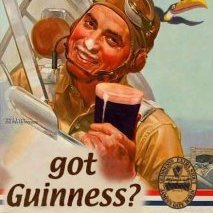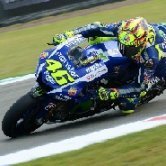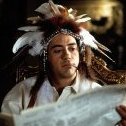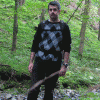

JMChladek
Members-
Posts
1,010 -
Joined
-
Last visited
-
Days Won
1
JMChladek last won the day on November 11 2012
JMChladek had the most liked content!
About JMChladek
- Birthday 18/11/1970
Profile Information
-
Gender
Male
-
Location
Bellevue, NE (USA)
JMChladek's Achievements

Very Obsessed Member (5/9)
166
Reputation
-

Prototype Boeing Dreamliner 1/144
JMChladek replied to bianfuxia's topic in Ready for Inspection - Aircraft
It may be a "basic" job, but you executed it very well. Sometimes it can be more difficult to do a clean appearing model properly as opposed to a dirty one and this one looks like and clean, yet still in scale. -
This work is outstanding. I have dreamed of doing something like this in 1/48 and with the Revell kit I can. But the Blackbird itself is only one part of the story. I love your "old school" fabrication solutions for the carts and ladders.
-

HABU! Revell 1/48 SR-71 Blackbird
JMChladek replied to Alan P's topic in Work in Progress - Aircraft
As far as I know, it will be. But due to supply and transportation issues brought about by the pandemic, most of the US based model companies are raising prices by about 15% across the board. So I have no idea how that will affect the final price. -

HABU! Revell 1/48 SR-71 Blackbird
JMChladek replied to Alan P's topic in Work in Progress - Aircraft
Yes we backward Americans do. Revell of Germany and Revell USA are owned by the same investment firm, but are maintained as separate divisions currently. It has resulted in some unique releases for the US market though. For instance the 1/32 P-51D without the tail fillet has different decal options from the RoG release. Why? The marking options on the US kit has kill markings done up as swastikas (which were accurate for the planes represented, Frenesci and Cripes A Mighty 3rd) while the RoG kit decal options were for planes with iron cross markings (which were accurate for the two specific planes being offered, one of which was Lou IV). I suspect RoG did this because it is still illegal to display the swastika in Germany, even as a kill marking. -

HABU! Revell 1/48 SR-71 Blackbird
JMChladek replied to Alan P's topic in Work in Progress - Aircraft
A Revell USA version of the kit is indeed in the pipeline with different box art and inch measurements. But there will be one important difference. The US version will only have 170 parts. It will not have the stand parts or the exposed J58 engine parts trees. It will only have just the Blackbird kit itself. So if you want the engines, the Revell of Germany kit will be the only source. I did some shopping for mine and ordered it from the Aviation Megastore in the Netherlands. It arrived at my home in Nebraska in a little less than a week. Money paid for it via PayPal was $124 US, shipping via UPS with tracking included. -

HABU! Revell 1/48 SR-71 Blackbird
JMChladek replied to Alan P's topic in Work in Progress - Aircraft
My word, that looks awsome!!! Great job amigo! Here's a Youtube link to a film Lockheed did towards the end of the Blackbird's operational career. I understand they were trying to sway public interest and see if they could stay the aircraft's execution. It didn't work, but it is probably the best record on film documenting for the public what was involved with SR-71 operations. I had a chance to see it in a movie theater in 1990 after the Blackbird was retired and got to talk with Col. Harlan Hain, who was an operations officer with the 9th SRW when the Blackbirds flew their first operational missions out of Kadena. This video was taken from a VHS tape so quality is a little degraded. But the resolution is good enough to make out details The plot of the story is a bit thin, but the fictionalized "crisis area" they are referencing seems to be based on the missions flown over the Arab Israeli conflict area during the Yom Kippur war. In that conflict, around the time of the cease fire, the Egyptians claimed the Israelis were over their side of the line. The Israelis denied it, but intelligence collected by Blackbird overflights verified that they weren't quite telling the truth. After the proof was submitted, further overflights verified that the troops were withdrawn back to where they should have been and things calmed down once again. -

HABU! Revell 1/48 SR-71 Blackbird
JMChladek replied to Alan P's topic in Work in Progress - Aircraft
I went down to the SAC Museum in Ashland, NE yesterday to look at our Blackbird. Since they have the plane itself up on stilts in an atrium, the gear struts and one of the engines are on display in one of the other areas. Revell modeled them that way since the pivot points they put in are on the actual gear. I think they knew the average modeler was probably going to add strength to the assemblies to do a gear down bird off the stand. But, with the display stand, it opens up the possibility to build the model with the gear going up. The retraction struts can be modified to do that and thanks to the pivot points being in the gear as designed by Revell, it is relatively easy to do now (or at least easier). I also like the fact that the gear doors can work open or shut. That avoids the issue of having to get gear doors only designed for gear down models to fit into the bays, which is a common problem with many other kits. It was an interesting visit. I was there in the museum, sitting under the blackbird with my Revell kit comparing features on the belly with the kit features and guess what... I would estimate that Revell got over 90% of the details right. They did those diamond cutouts just behind the nose, the big blade antenna and the cylindrical flat spot in front of the nose gear bay. Panels we lining up nicely from nose to tail. I only found maybe two round inspection hatches back near the central mounted control surfaces missing and a panel line gone from the bottom of each engine. But as far as I could tell, everything else was there. Only other things I found missing are four very small pitot ports that sit about 120 degrees apart from one another on each engine pod behind the intakes (one top, one below, both outboard of the intake centerlines). They are very tough to spot in photos and I figure Revell kept them off to keep modelers from knocking them off the completed model. Based on what I could see, we already know this is currently the best Blackbird model out there. But it isn't just the shape. Revell got a lot of minor stuff right. So a modeler doing an out of the box build can build a most impressive model while there is still enough left for the superdetailers with AMS to go nuts if they desire. -

HABU! Revell 1/48 SR-71 Blackbird
JMChladek replied to Alan P's topic in Work in Progress - Aircraft
Beautiful build thus far. I am really liking the results! I live in the states and I bit the bullet to get mine sent from the Netherlands. It just arrived today and I am most impressed with it. It puts the old Testors kit to pasture. I have access to a museum Blackbird near where I live and I checked its paint with what I had on hand when I built a 1/72 Hasegawa Blackbird a decade ago. At the time, Floquil Grimy Black was the best colour I found to use. Floquil is gone today though. As for colours to try, Tamiya Rubber Black, either spray or airbrushed is a good basis. Tamiya NATO black can work as an accent colour. One obvious place to put in a "tan line" as it were is the nose. Typically the more secretive mission noses are kept indoors and not attached to a Habu until it is being prepped for a mission. It's not uncommon to see a nose either darker than the rest of the airframe, or lighter. There can also be a slight colour change from the fuselage just in front of the wings to the main body. Don't go too crazy on weathering since these birds tended to be hangered when they weren't flying. The question was asked about the IFR door. When a Blackbird was powered down, the door was open, even on the ground. This was a safety feature added by Kelly Johnson himself. If a Blackbird lost its generators in flight (which has happened) he didn't want the aircraft to lock out its IFR door because then hookup to the tanker would be very critical since the plane consumes more fuel at slower speeds. If power is lost, the door drops open exposing the IFR receptacle On the ground, dirt isn't really a concern as the birds are hangered and meticulously inspected during preparations for a mission (unless the ground crew had a way to manually crank the IFR door shut) or use some sort of lockout pin. Somebody asked about pressure suit colors. In the 60s they were white (A-12 pilots wore a silver suit). In the 70s they were changed to a brown shade similar to a military uniform dark brown. A blue suit has also been seen but I do not know how common it was (possibly only used in the YF-12?). In the very late 70s it was changed to a colour called "Old Gold" which is a orange/yellow shade, like about two thirds yellow to 1/3rd orange. You don't necessarily have to get it exact, just close as it looks like newer suits are a little brighter in colour than the older ones. The exact same suits were used by NASA Space Shuttle crews on the first four test missions. So you can consult images of those suits for references. On my build, I am going to scrounge a pair of astronauts from a Revell 1/48 Apollo CSM kit as the Block 1 style suits used during Apollo 1 (which Revell rendered in their Block 1 CSM based kit) were made by Dave Clark corporation and were heavily based on the Gemini suits. The S-1030A suits used by later Blackbird crews are also relatives to the NASA Gemini suits and made by Dave Clark corporation. The engine flame bucket internals were indeed covered with a tan ceramic coating. I once stuck my head in a J58 on display separately from the Blackbird we have at the SAC museum in Ashland, Nebraska as I was getting measurements for a possible resin engine insert to use in the Testors kits. Unfortunately the resin firm no longer exists as it burned up in the California wildfires a few years back. But, nice to know we don't need one now for any OOB builds of the Revell kit. Resin or 3D print ones sound appealing though if one were to do a diorama of a Blackbird starting engines as you see a green flash of TEB igniting in the chamber. Museum engines are perfectly acceptable for research since they were pulled out of the planes on display and pretty much kept looking pristine with no repaints. After I get a little more research done, I'll start work building mine this week. Thanks for the build tips! -

Tamiya F-15C, 1/48th Lakenheath Eagles...
JMChladek replied to Airgunner's topic in Work in Progress - Aircraft
For somebody that doesn't like doing jets, you are doing an outstanding job on this! -

A Restoration of an Airfix F-16
JMChladek replied to Brigbeale's topic in Work in Progress - Aircraft
Aircraft 7 and 8 were the two seaters and this goes back to the F-16A/B jets from back in the day. Later on with the C/D jets, it looks like they had a D primarily used for #4 slot work (possibly to use for filming that season since mounting a camera in a two seater is a lot easier than a single seater). The only other thing to keep in mind is the Thunderbirds were equipped with Block 15 jets which featured longer horizontal stabs. The Airfix kit represents block 5 and 10 jets, which had the original short stabs. Airfix did tool up new longer stabs for the most recent pressing of that kit. If you can't acquire any longer stabs, don't sweat it too much. She should look fine with the original stabs in T-birds colors. I built the MPC version of the Airfix kit when I was a kid and IMHO it built into a nice model. I recently acquired a Heller example (same plastic). Sure she may not be a later Revell or Hasegawa example, but the kit was not bad for what you got and at the time it was one of the few F-16s that had the A and B option in the box. -
Might that also include Black on Black Aussie Ford Falcons prowling the wastelands?
-
In good ole anti flash white I trust? Nice.
- 11 replies
-
- B-1
- Flight Test
-
(and 1 more)
Tagged with:
-
Yes I am up for this. It could be a 1/48 or a 1/72. Don't quite yet know the specific subject yet as I have a few ideas floating around from either a F-14 FSD bird, to a VF-32 Mig Killer, to a VF-1 first cruise or a Top Gun F-14. And no, I can't do them all. I can only do one of these
-
Great pictures. I am currently wrapping up a Minicraft (Entex) B-1A build. I am doing this bird in this livery using the decals from the Panda B-1B "Test Program" kit.
- 11 replies
-
- B-1
- Flight Test
-
(and 1 more)
Tagged with:
-
Minor correction on the photo captions. The images of the B-1 from March of 1981 are actually of ship #4, not three. The big identifier are the black patches in front of the wings as only #4 had those. Ship #3 never did. #0174 was also equipped with ejection seats rather than the ejection capsule, so the window frames look a little different. If you look close, the side post angles are different. They sweep forward on the capsule equipped jets while on 0174 they are almost straight up and down (same as on the B-1Bs). Also the ejection capsule equipped B-1s all have a "mohawk" protrusion just above the cockpit. From what I have been able to find, but ship #3 and ship #4 were given the extended spine and apparently wore it at the same time for awhile. Ship #4 was equipped with it as it was selected along with ship #2 (0159) to take part in the B-1B test program while ships #1 and #3 weren't utilized as much since they were higher time airframes (ship #3 was the second B-1A to fly. Ship #2 took longer to finish since it was used as a static test airframe before it got rebuilt for flight test). Ship #3 eventually got the spine removed. Ship #4 was used in offensive/defensive avionics testing and got the blunted rear cone while Ship #3 kept its pointed B-1A tail cone. As for why #0158's tail looks a little different, the fin cap had been removed. The plane as I understand it had ended its flying days. So by that point she was mostly a parked display bird. It is a pity that she never got put in a museum and ended up getting scrapped. Today, Ship #3 which is the only remaining B-1A with the ejection capsule is on display in the Wings over the Rockies museum near Denver, CO. Ship #4 is on outdoor display at the SAC Museum near Ashland, NE. Her elevators have been removed and the paint turned some weird funky shades when she was placed outside, but otherwise she looks pretty good.
- 7 replies
-
- 1
-

-
- Edwards AFB
- Flight Test
-
(and 1 more)
Tagged with:









